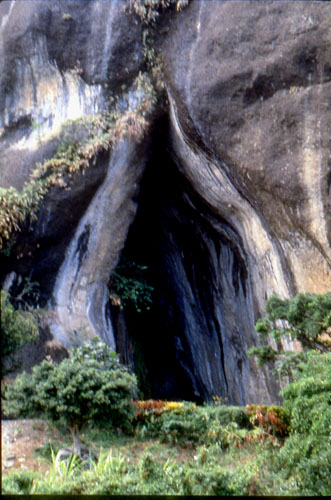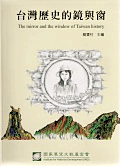張貼時間: 2008-06-26 14:55:22
 台灣舊石器時代遺址
台灣舊石器時代遺址台東縣長濱鄉八仙洞
在台灣的史前文化中,最久遠的要算是分布在東部及恒春半島海岸的「長濱文化」。1968年,台大考古隊在台東縣長濱鄉八仙洞發現長濱文化的遺址,其豐富的舊石器階段的先陶文化,至少在一萬五千年前,甚至早到距今五萬年前。另外,在台南縣左鎮鄉菜寮溪河床上所出土的部分人骨化石,經鑑定有二、三萬年之久。學者認為這種「左鎮人」可能亦屬長濱文化期的人類遺留。
(台灣歷史閱覽,壹、 遙遠的老台灣�李筱峰 劉峰松 合著)
2009年中研院率領的考古團隊在進行岩心鑽探及洞穴探掘,發現舊石器時代人類的火塘遺跡(即生火之處),經碳14鑑定年代為距今20000到25000年,有了明確證據解釋長濱文化的年代。這項考古計畫由中央研究院歷史語言研究所副所長臧振華博士主持,在八仙洞遺址發現了7處新的洞穴,使八仙洞的洞穴數目達到24處,這是新發現之一。另外,在57處地點進行岩心鑽探及7處洞穴探掘,發現了大量舊石器與新石器時代的遺物。
 八仙洞遺址 發現舊石器火塘(黃明堂/自由時報2009/07/26)
八仙洞遺址 發現舊石器火塘(黃明堂/自由時報2009/07/26) 下文摘錄自「台灣的史前文化」�作者劉義昌。《台灣歷史的鏡與窗》,發行人:施政鋒,主編:戴寶村,出版者:財團法人國家展望文教基金會,台北市,2006年5月二版。
《台灣歷史的鏡與窗》由台灣歷史學會、Taiwan News、以及國家展望文教基金會合作:台灣歷史學會的會員書寫、Taiwan News負責翻譯以及報紙呈現、國家展望文教基金會負責協調以及書籍出版。
下文摘錄自「台灣的史前文化」�作者劉義昌。《台灣歷史的鏡與窗》,發行人:施政鋒,主編:戴寶村,出版者:財團法人國家展望文教基金會,台北市,2006年5月二版。
《台灣歷史的鏡與窗》由台灣歷史學會、Taiwan News、以及國家展望文教基金會合作:台灣歷史學會的會員書寫、Taiwan News負責翻譯以及報紙呈現、國家展望文教基金會負責協調以及書籍出版。已記錄將近2000個遺址
台灣(及附屬島嶼)自西元1896年發現第一個史前遺址--芝山岩遺址以來,考古學家在這片土地上記錄 了將近二千個遺址。分布的範圍幾乎遍及台灣本島及澎湖群島、綠島、蘭嶼、小琉球等附屬島嶼。垂 直高度的分布則從海平面附近數公尺起的海岸平原,到高達2950公尺左右的山地,比民族誌記載的原 住民族最高的聚落還高。這些遺址的長期研究工作,已經初步建立了一個史前文化發展的大架構及其 演變體系,也可以說明一部份史前文化與當代原住民族之間的關係。
劃分了許多不同的考古文化單位
依時間的早晚,分布區域的不同和文化相貌的差異可以分為許多不同的考古文化單位,由於不知道這 些文化擁有者人群的名稱,考古學者以具有代表性的遺址來稱呼他們。由早期到晚期大致分為:
1. 舊石器時代:包括長濱文化、網形文化、左鎮人。
2. 新石器時代早期: 以大坌坑文化為代表。
3. 新石器時代中期: 以訊塘埔文化、牛罵頭文化、牛稠子文化、「東部繩紋紅陶文化」為代表。
4. 新石器時代晚期: 以芝山岩文化、圓山文化、丸山文化、營埔文化、大馬璘文化、大湖文化、鳳 鼻頭文化、卑南文化、花岡山文化、麒麟文化為代表。
5. 金屬器與金石並用時代:以十三行文化、二本松文化、番仔園文化、大邱園文化、崁頂(貓兒干) 文化、蔦松文化、北葉文化、龜山文化、靜浦文化、Lobusbussan文化為代表。
在台南縣所發現的左鎮人
左鎮人出土於台南縣左鎮鄉菜寮溪河床,這個地區是台灣本島相當重要的更新世化石產地,也是當時 唯一出現化石人類的地點,不過最近高雄縣大崗山區也發現了人類的化石。左鎮人的化石標本包含來自不同個体的人類頂骨殘片及大臼齒。經鑑定屬於更新世晚期的早期智人,其絕對年代可能在距今二萬到三萬年之間,也就是更新世冰河時代的最後一次冰河時期。目前並未現左鎮人使用的工具,學者推測他們也許是長濱文化的主人,不過從生活型態而言,更接近住在丘陵台地地區的網形文化人。
Taiwan's prehistoric cultures
I-chang Liu, Research Fellow, Institute of History and Philology, Academia, Academia Sinica, Nankang, Taipei
Nearly 2,000 sites already recorded
Taiwan's first prehistoric site was discovered in 1896. Since the uncovering of the Chihshanyen site, archaeologists have recorded almost 2,000 different sites. The geographical range covered includes nearly all of the island of Taiwan, and the surrounding islands, including the Penghu Archipelago, Green island, Orchid Island and Hsiao Liuchiu. Vertically, distribution ranges from coastal plains a few meters above sea-level to mountains at a height of about 2,950 meters, which is higher than the highest aboriginal villages in the ethnographic record. Long-term research work on these sites has already preliminarily established a framework for prehistoric cultural development and its evolutionary system, and can explain the relationship between part of prehistoric culture and contemporary aboriginal tribes.
Many different archaeological culture subsections
The culture left behind by prehistoric peoples in Taiwan can be divided into many different archaeological cultural subsections according to how early or late they are on the time-scale, geographical distribution and differences in cultural features. Since we don't know the names of the groups of peoples who had these cultures, archaeologists name them after the sites which represent their culture. From earliest to latest, we can make these approximate divisions:
1. Paleolithic Period, including Changpin Culture, Wanghsing Culture, Tsuo Chen Man;
2. Early Neolithic Period, represented by Tapenkeng Culture;
3. Mid Neolithic Period, represented by Hsuntangpu Culture, the Niumatou Culture, the Niuchoutzu Culture, the "Eastern Fine-Red-Corded Terracotta Culture;"
4. Late Neolithic Period, represented by Chihshanyen Culture, Yuanshan Culture, Wanshan Culture, Yingpu Culture, Tamalin Culture, Tahu Culture, Fengpitou Culture, Peinan Culture, Huakangshan Culture and Chilin Culture;
5. The age of metal and metal-and-stone tools: represented by Shih San Hang Culture, Erhpensung Culture, Pantsaiyuen Culture, Tachiuyuen Culture, Kanting (Maoerhkan) Culture, Niaosung Culture, Peiyeh Culture, Kueishan Culture, Chingpu Culture and Lobusbussan Culture.
Tsuo Chen Man, discovered in Tainan County
Tsuo Chen Man was excavated from the Tsai Liao River bed in Tsuo Chen Township, Tainan County. This area is a fairly important Pleistocene-era fossil site on the main island of Taiwan, and it was also the only place where fossilized human remains have been found until the recent discovery of fossilized human remains in Kaohsiung County's Takangshan region. Samples from the fossilized remains of Tsuo Chen Man contain parietal bone fragments and molars from different bodies. Having been identified as an early Homo sapiens from the late Pleistocene era, his precise date can be fixed at between twenty and thirty thousand years ago, which is the last ice age of the pleistocene ice age era. The tools used by the Tsuo Chen people have not yet been dicovered, and scholars infer that they were perhaps the masters of the Changpin Culture. However, in their lifestyle, they were closer to the Wanghsing people living the hill-plateau areas.